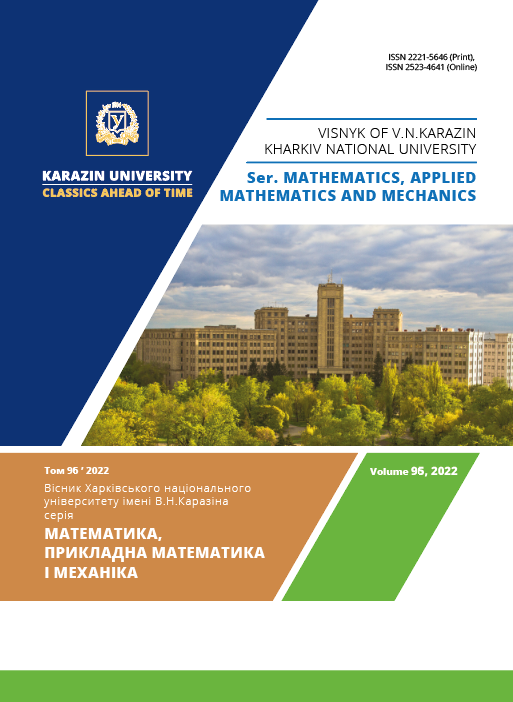Control of wheeled platforms straight motions taking into account jerk restrictions under speeding-up from the state of rest
Abstract
The generalized mathematical model of wheeled platforms straight motions on the ideal horizontal plane under speeding-up from the state of rest mode is proposed, and the controls satisfying the restrictions of motion jerks are find. The pure mechanical and electromechanical wheeled platforms are considered, as well as the computer simulations of the researched processes are made. The jerks restrictions are reduced to limiting the value of the wheeled platform acceleration time derivative. The proposed approaches are based on the holonomic systems mechanics and on the electromechanical analogies allowing to consider the different kinds of the wheeled platforms taking into account the electric on-board systems like the drive electric motors and the control systems by using the Lagrange equations of second kind. The examples of the proposed approaches using to define the controls satisfying the jerks restrictions under speeding-up from the state of rest are considered for the pure mechanical and electromechanical wheeled platforms. It is obtained the inequality allowing to chose the instantly supplied driving mechanical couple which will provide the admissible jerks of the motion of the wheeled platform under speeding-up from the state of rest. It is shown that the rolling friction and the viscous damping are the principal causes of the wheeled platforms jerks under speeding-up from the state of rest. It is obtained the inequality defining the voltage instantly supplied on the drive electric motors which will provide the admissible jerks of the motion of the electromechanical wheeled platform during speeding-up from the state of rest, and it is shown that the proposed general approaches are suitable for considering the different kinds of wheeled platforms. The computer simulations of the processes of speeding-up from the state of rest for the electromechanical wheeled platform are considered to show results correctness and to illustrate satisfying the restrictions of the motion jerks. The obtained results of the computer simulations are in the full agreement with the well-known fundamental property inherent for the wheeled platforms. The results for the jerks show that the maximum value of the jerk is really at the initial time as was suggested before, and it is shown that the jerks values at the initial time obtained by using the computer simulations are in full agreement with the theoretically defined correspondent exact values. The big jerks of the considered electromechanical wheeled platform are due to the voltage instantly supplying on the drive electric motors at the initial time, and it is understandable that limiting of such instantly supplied voltage value cannot provide any wished small jerks. The smooth time depending for the voltages supplying on the drive electric motors are required to provide any wished small jerks of the electromechanical wheeled platforms.Downloads
References
A. Scamarcio, P. Gruber, S. De Pinto, A. Sorniotti. Anti-jerk controllers for automotive applications: A review, Annual Reviews in Control. -- 2020. -- Vol. 50. -- P. 174--189. DOI: https://doi.org/10.1016/j.arcontrol.2020.04.013
G. Fracchia, J.D. Biggs, M. Ceriotti. Analytical low-jerk reorientation maneu-vers for multi-body spacecraft structures, Acta Astronautica. -- 2021. -- Vol. 178. -- P.~1--14. DOI: https://doi.org/10.1016/j.actaastro.2020.08.020
J.-w. Ma, S. Gao, H.-t. Yan, Q. Lv, G.-q. Hu. A new approach to time-optimal trajectory planning with torque and jerk limits for robot, Robotics and Autonomous Systems. -- 2021. -- Vol. 140. -- 103744. DOI: https://doi.org/10.1016/j.robot.2021.103744
S. Alyokhina, I. Nevliudov, Y. Romashov. Safe Transportation of Nuclear Fuel Assemblies by Means of Wheeled Robotic Platforms, Nuclear and Radiation Safety. -- 2021. -- Vol. 3, No 91. -- P.43--50. DOI: https://doi.org/Doi: 10.32918/nrs.2021.3(91).05
R. Sato, K. Shirase. Analytical time constant design for jerk-limited acceleration profiles to minimize residual vibration after positioning operation in NC machine tools, Precision Engineering. -- 2021. -- 71. -- P.47--56. DOI: https://doi.org/10.1016/j.precisioneng.2021.02.009
M.-A. Beaudoin, B. Boulet. Fundamental limitations to no-jerk gearshifts of multi-speed transmission architectures in electric vehicles, Mechanism and Machine Theory. -- 2021. -- Vol. 160. -- 104290. DOI: https://doi.org/10.1016/j.mechmachtheory.2021.104290
A. Barreiro, A. Banos, E. Delgado. Reset control of the double integrator with finite settling time and finite jerk, Automatica. -- 2021. -- Vol. 127. -- 109536. DOI: https://doi.org/10.1016/j.automatica.2021.109536
A.G. Mamalis, I. Nevliudov, Yu. Romashov. An approach for numerical simulating and processing of measured electrical signals from board sensors installed on wheeled electro-mechanical platforms, Journal of Instrumentation. - 2021. - Vol. 16, No 10. - P.10006. DOI: https://doi.org/10.1088/1748-0221/16/10/P10006
G. Klancar, M. Loknar, S. Blazic. Towards Time-Optimal CACD Motion Primitives with Smooth Transitions, IFAC-PapersOnLine. - 2020. - Vol. 53, No 2. - P.15544--15549. DOI: https://doi.org/10.1016/j.ifacol.2020.12.2398
G.M. Ismail, H. Abu-Zinadah. Analytic approximations to non-linear third order jerk equations via modified global error minimization method, Journal of King Saud University - Science. - 2021. - Vol. 33, No 1. - 101219. DOI: https://doi.org/10.1016/j.jksus.2020.10.016
F.R. Gantmakher. Lectures on Analytical Mechanics. --1966. (in Russian).
A.S. Poznyak. Classical and Analytical Mechanics. - 2021. DOI: https://doi.org/10.1016/C2020-0-01741-X
The copyright holder is the author.
Authors who publish with this journal agree to the following terms:
1. Authors retain copyright and grant the journal right of first publication with the work simultaneously licensed under a Creative Commons Attribution License that allows others to share the work with an acknowledgement of the work's authorship and initial publication in this journal. (Attribution-Noncommercial-No Derivative Works licence).
2. Authors are able to enter into separate, additional contractual arrangements for the non-exclusive distribution of the journal's published version of the work (e.g., post it to an institutional repository or publish it in a book), with an acknowledgement of its initial publication in this journal.
3. Authors are permitted and encouraged to post their work online (e.g., in institutional repositories or on their website) prior to and during the submission process, as it can lead to productive exchanges, as well as earlier and greater citation of published work (see The Effect of Open Access).




